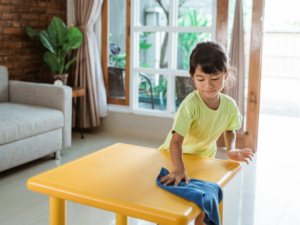Creating healthy baby sleep habits is like baking a cake. For a successful outcome, you have to have all of your ingredients on hand, each one measured to perfection. The ingredients for good sleep consist of the proper environment, nutrition, and emotional well-being.
Ingredient 1: Healthy Baby Sleep Environment
Sleep environment is the first and most important factor to address. For babies and young toddlers, the best and safest place to sleep is in a crib. When a baby resists sleep, parents often worry that it means the baby hates cribs. Babies actually love cribs because the four walls of the crib give a sense of security. If your baby is not falling asleep easily in the crib, it is most likely because of another factor, such as being overtired, overstimulated, gassy, hungry, etc.
According to the American Academy of Pediatrics, babies should ideally sleep in a crib from birth to 36 months. This is because children younger than 36 months cannot comprehend the concept of staying in a bed without “walls.” However, the exception to this rule is if a child climbs out of the crib. For safety, crib climbers should be transitioned to a toddler bed with guard rails on the open sides.
The bedroom should always be dark for both naps and bedtime. Blackout shades are very effective in eliminating light completely from the window. Darkness is not only relaxing, but it also triggers melatonin (the sleepy hormone) production.
Lastly, a healthy baby sleep habit includes ensuring the bedroom should only be used for sleep. When other activities, such as eating or playing, are avoided, it gives children a clear message that the bedroom is for going to sleep.
Ingredient 2: Nutrition and Healthy Baby Sleep Habits
Nutrition plays a big role in sleep as well. Babies ages 0-12 months need to have a predictable feeding schedule. Consistent feeding times will inevitably help to create a sleep schedule. This is because the baby is learning to distinguish between hunger and sleep. Playing the hungry-or-tired guessing game every time a baby cries will confuse a baby’s hunger and sleepy cues. Check with your pediatrician to find out exactly how many feedings your baby needs and how far apart, based on the baby’s growth.
Toddlers also thrive on scheduled meals. Predictability and routine throughout the day will help get their bodies and brains ready to sleep during nap or bedtime. Limiting processed sugar, caffeine, and artificial colors or flavors from lunchtime and on is ideal. These foods can cause hyperactivity and difficulty falling asleep.
Ingredient 3: Emotion Well-Being and Healthy Baby Sleep
The emotional well-being of a child’s home is the “icing on the cake.” Starting as young as one day old, babies and toddlers are strongly connected to and affected by their parent’s emotions. If there is unusual or new stress in the home, parents will likely see more sleep issues in their children. While it is impossible to change life circumstances, it is important to make yourself aware of its effect on your children. If a baby or toddler senses that their parent is tense, it will be harder for them to relax and go to sleep. Before putting your child to sleep, take a few moments to calm yourself in the way that is most comfortable for you. For example, take some deep breaths, drink water, and step outside for fresh air. There will be a noticeably big difference in the calmness of your child. Make time for self-care at least one to two days a week to help lessen your stress level.
Toddlers that are verbal can also benefit from emotional work. Some age-appropriate activities include talking with your older toddler about their feelings toward different situations, keeping a color journal where they color a picture of feelings, or doing a sensory activity like playdough an hour before nap or bedtime.
Final Thoughts
It takes time and practice to set up the proper foundations mentioned above. After a few days to a few weeks of practice and making changes, your entire family will reap the benefits!
Next Steps
Ask your concierge about sleep preparation activities you can do with your child if you haven’t already done them. We have prepared some quick things you can do before to help you and your baby get the sleep you both need.




